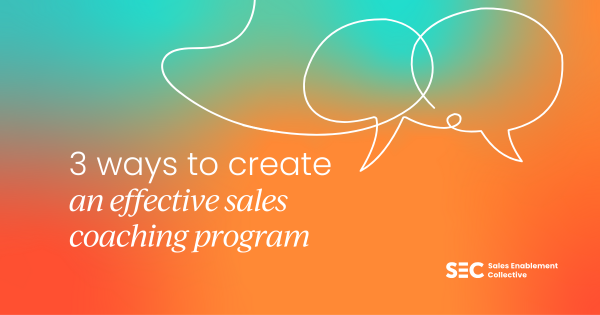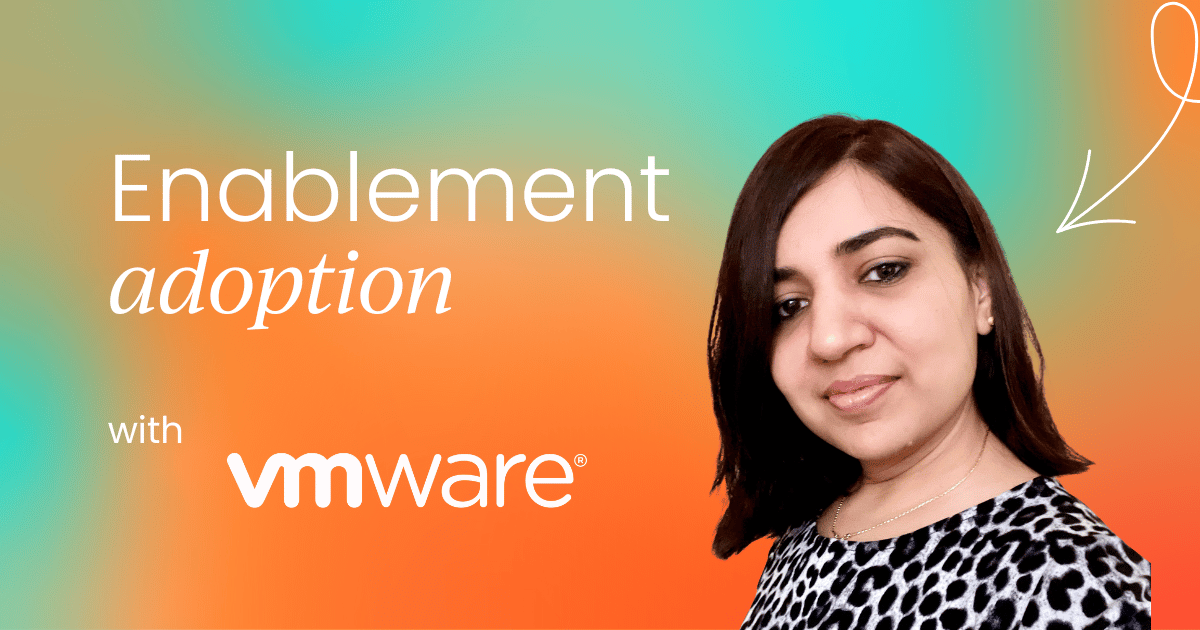Strong adoption of sales enablement programs is imperative for the success of the enablement team’s charter and is an indicator of their continued value to the organization.
Enablement adoption is also a strong measure of how well the program aligns with the sales organization’s vision and objectives and how strongly it meets the core learning needs of the target sales reps.
B2B sales enablement pros can envision, design, and build the best enablement programs to support their sales teams, but low adoption rates, poor consumption/registration numbers, and a lack of interest in the program are very real problems that enablers often face.
Poor adoption rates signal a low return on investment (ROI) on the efforts of sales enablement teams and are often a result of gaps in the overall enablement process.
So, what are the common reasons for poor reception and low consumption of enablement programs and how can sales enablement professionals avoid them? Here are a few key questions to consider and assess against.
Do the sales teams need your program?
Identifying and validating the need for enablement is a mandatory first step that must be completed before designing an enablement program.
This means not only looping in the sales leaders on the enablement proposal, but also engaging key representatives from the sales teams to assess the appetite for the proposed enablement.
Reviewing the key objectives, high-level outline, and major focus areas for the enablement with these stakeholders is a great way of ensuring that the enablement is targeted at solving a real, identified business need such as (but not limited to):
- Bridging a competency or a skill gap.
- Providing learning solutions for an identified gap in product, solution, process, tools, or go-to-market knowledge.
- Supporting any transformational initiatives across the business that impact roles, processes, and tools.
- Updating any existing enablement programs, such as product learning paths, sales onboarding, sales leader enablement, sales methodology, and more.

Do you have buy-in from the sales leadership for your sales enablement program?
Securing buy-in and sponsorship from sales leaders upfront is a critical milestone in the enablement process.
Ensuring your sales leaders are aligned with the need and value of the proposed enablement program and can be counted on to call upon their reporting hierarchy of managers and sales teams to consume the program.
Sometimes, a simple e-mail, a brief segment in an ‘All Hands’ meeting, or a two-minute promotional video from the sales leader to their team on the importance of the program can provide the necessary ambassadorship and backing needed to get the sales teams interested in the program even before it has launched.
Continued encouragement from sales leaders while the enablement program is live is also helpful in keeping the momentum going and motivating sales teams to complete the program.
Do the sales teams know your program exists?
Sometimes a less-than-ideal adoption rate of a sales enablement program is a result of poor communication and awareness efforts.
Enablers should ensure that all new sales enablement programs are executed with a carefully designed communications plan. This plan should include the deployment of communication and awareness interventions before, during, and after the program so that:
- If the program is synchronous (such as an instructor-led training or webinar), sales teams are cognizant of when the program is launching and can plan to register and attend the same.
- If the program is asynchronous (such as a self-paced training, a video, or a just-in-time resource), sales teams can set aside time within the program deadline, if applicable, to consume the program contents as part of their day-to-day job.

Are the contents of your enablement program directly relevant for sales teams?
High content relevance and appropriate content depth are absolute requirements for an enablement program to be successful.
If your sales teams find that the content has significant information gaps, is duplicative, or is not deep enough, they will not be motivated to consume the program in its entirety (which will impact the completion rate). They’ll also be less likely to refer the program to their peers (which will impact the net promoter score for the program).
Therefore, it’s key to ensure the core information included within the enablement program is accurate, complete, relevant, and appropriate for the targeted sales teams.
There is often a gap between what the subject matter experts (i.e., product or marketing teams who provide inputs or source materials for enablement) think is relevant vs. what is really important to those in sales roles.
Often, piloting the program with a small group of sales team members before the full roll-out, or conducting content reviews with identified “champions” within the sales teams before launch can easily help validate whether the designed program meets the learning objectives it set out to achieve.
This allows the flexibility for any necessary pivots and for any identified gaps/deviations to be addressed ahead of time.

Is your enablement program too monotone?
Sometimes, a given sales enablement program can have sufficient sponsorship, be focused on a valid business need, and have the appropriate content, but it may still suffer from low adoption rates because of how it’s structured and how the information is packaged and dispersed.
This is where the Instructional Design function within the enablement team becomes important.
Instructional Design experts focus on learning behaviors. They leverage creative learner experience design strategies that consider how different people learn.
Some ways to add variety to your program and cater to different learning styles include:
- Chunking the enablement content into bite-sized pieces (for example, micro-learning).
- Providing a multi-modal experience (for example, instructor-led, video-based, self-paced, or just-in-time/offline).
- Threading in opportunities for application and practice (for example, knowledge checks, assessments, scenarios, or simulations).
- Including strategies that foster content retention and recall (for example, drip learning).

Is the “user” experience not ideal for sales teams?
Another aspect of Instructional Design that may often be overlooked is the experience of sales teams as “end-users” as they go through the program.
How an end-user navigates through the contents of an enablement program and how easily they’re able to find and consume this content are directly related to the speed of rep adoption and overall quality of experience.
To ensure the best user experience for their sales teams, enablement professionals must conduct a review of all peripheral systems that the enablement program depends on to deploy and host its contents.
This may include a Learning Management System (LMS), a Learning Content Management System (LCMS), a Learning Experience Platform (LXP), a video hosting platform, internal websites, wikis, internal shared drives (such as OneDrive, Box, Google Drive), etc.
The flow of information from one system to another should be seamless, accessible, intuitive, and integrated in such a way that end-users can:
- Easily navigate across systems.
- Understand and use the basic functionality of each system intuitively.
- Quickly search for and access the information they need.
- Progress from one section to another without any glitches.
- Have a contact they can reach out to for support if they get stuck.

Does the roll-out timing of your enablement program conflict with any key events?
Before rolling out their enablement program, consider any key events that may be on the horizon and have the potential to be in direct conflict with the program launch.
Yearly events such as sales kick-off, annual customer/marketing events, key industry events, and quarterly events such as quarter close and fiscal year close can compete for the attention of sales teams and cause them to be more strapped for time, and therefore less engaged and motivated to participate in the enablement program.
Are there any parallel efforts that overlap with your enablement program’s objective?
Similar to key events described above, sales enablement professionals should also assess that there are no internal cross-functional/cross-team initiatives in progress that may overlap with their enablement program’s objectives.
In bigger organizations where the enablement charter may be shared across different teams, it’s best practice to stay in touch with cross-functional peers and be in the loop on their enablement plans and projects.
Parallel programs or complementary but isolated initiatives have the potential to compete with each other for the sales team’s attention. This results in wasted cycles and poor adoption rates for both programs.

Are there opportunities for feedback within your enablement program?
Finally, there may be factors outside of the control or knowledge of the sales enablement team that may act as a hindrance to the overall adoption of an enablement program.
To address this, make sure there are built-in opportunities for feedback within your enablement program to allow the sales teams to share their feedback, opinions, and suggestions in real-time with the sales enablement team.
By integrating an external survey form, leveraging tool-specific native feedback capabilities, or providing a simple e-mail alias to contact, sales enablement professionals can ensure that any critical feedback that impacts the quality or relevance of enablement content can be flagged and addressed quickly.
Final thoughts
A lot of time, effort, resources, and budget goes into designing, developing, and deploying great sales enablement programs.
Following these simple and proven best practices can help to ensure the smooth adoption of enablement initiatives by sales teams and enable them to garner more impressive consumption and satisfaction metrics that showcase and highlight their team’s success.


Sales enablement insider
Thank you for subscribing
Level up your sales enablement career & network with sales enablement experts
An email has been successfully sent to confirm your subscription.
 Follow us on LinkedIn
Follow us on LinkedIn





